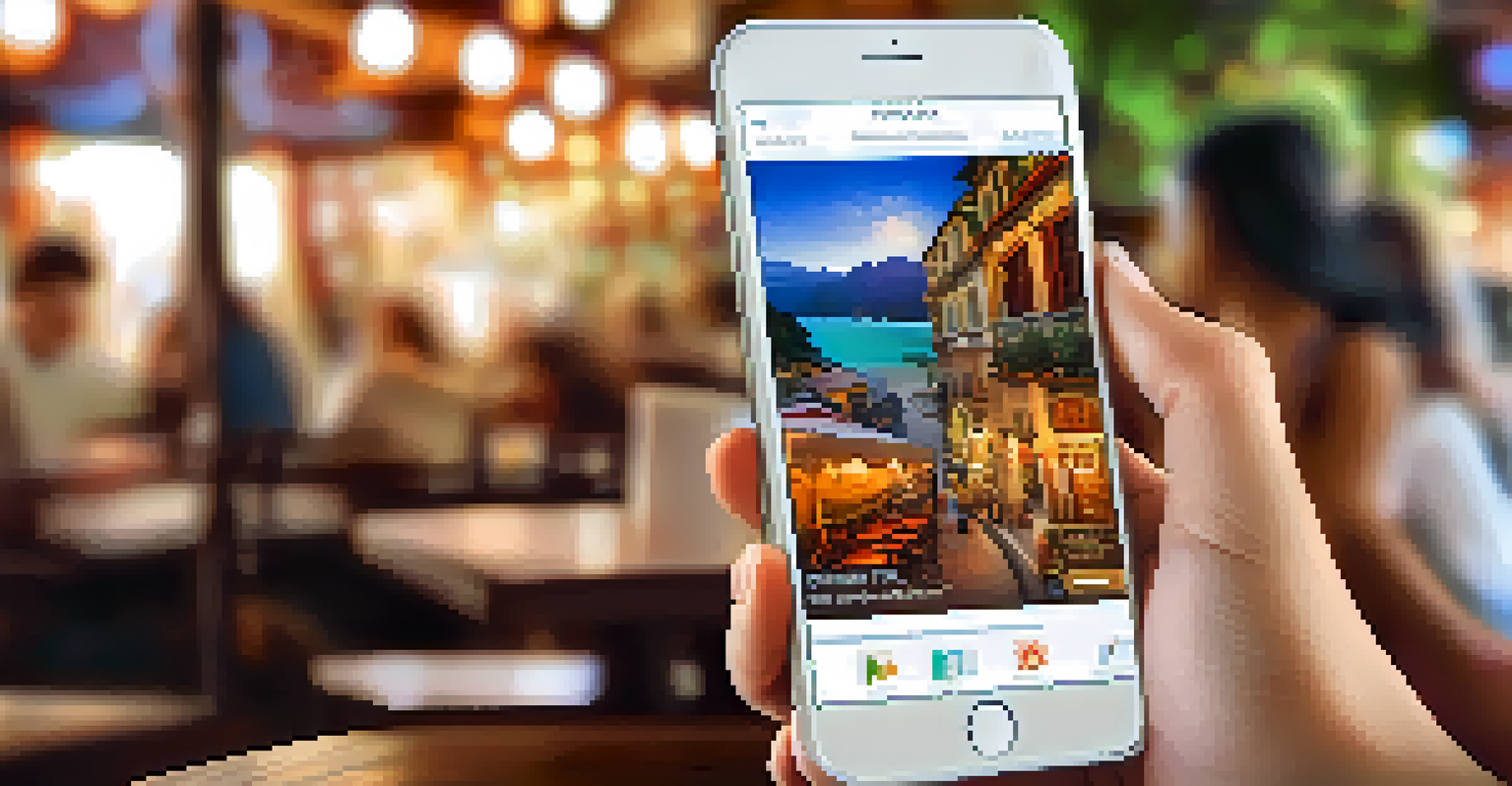The Impact of Social Media on Travel Trends Today

The Rise of Social Media as a Travel Resource
Social media has transformed the way we gather information about travel destinations. Gone are the days when travel brochures and guidebooks were our only sources of inspiration. Platforms like Instagram and Pinterest serve as visual treasure troves, showcasing stunning locations and unique experiences. A single post can ignite a wanderlust that leads to spontaneous trip planning.
Travel is the only thing you buy that makes you richer.
When travelers share their adventures online, they create a ripple effect that influences others. Friends and followers often turn to these posts for recommendations, finding authentic experiences that traditional advertising can't match. This peer-to-peer sharing fosters a sense of community and connection, making it easier to explore new places.
Additionally, hashtags and location tags allow travelers to discover hidden gems that might not be on mainstream travel lists. This democratization of travel content empowers individuals to seek out lesser-known destinations, enriching their travel experiences and promoting local cultures.
Influencer Culture and Its Effects on Travel Choices
The rise of social media influencers has significantly changed how destinations market themselves. Travel influencers curate visually appealing content, which can lead to dramatic shifts in tourist traffic. For example, once a location appears on an influencer's feed, it can quickly become a trending destination, drawing in crowds eager to replicate the experience.

However, this phenomenon can lead to 'overtourism' in popular spots, where the influx of visitors strains local resources. Destinations must balance the benefits of social media exposure with the need to preserve the integrity of their environment and culture. This challenge calls for innovative solutions to manage the impact of increased tourism.
Social Media Shapes Travel Choices
Platforms like Instagram influence travelers by showcasing authentic experiences and hidden gems.
Moreover, influencers often highlight sustainable travel options, encouraging their followers to make mindful choices. By promoting eco-friendly practices and supporting local businesses, they can inspire a more responsible approach to travel that benefits both visitors and communities.
Social Media and the Rise of Experiential Travel
Social media has shifted the focus of travel from mere sightseeing to immersive experiences. Travelers now seek out activities that provide authentic cultural interactions, such as cooking classes or guided tours with locals. These experiences often take center stage in social media posts, showcasing the depth of travel beyond just picturesque landscapes.
To travel is to discover that everyone is wrong about other countries.
The desire for unique experiences is fueled by the fear of missing out (FOMO), as travelers want to share their adventures in real-time. This trend encourages destinations to offer bespoke experiences that cater to diverse interests, creating a win-win for both tourists and local businesses. It’s not just about visiting a place; it’s about living it.
As experiential travel gains popularity, social media plays a vital role in shaping these trends. Platforms like TikTok showcase short, engaging videos that inspire users to try new activities, from hiking hidden trails to attending local festivals, further enhancing the joy of discovery.
The Role of User-Generated Content in Travel Marketing
User-generated content (UGC) has become a powerful tool in travel marketing. Authentic photos and reviews from fellow travelers lend credibility to destinations, creating a sense of trust among potential visitors. A beautiful beach photo shared by a friend can be more persuasive than any professional advertisement.
Travel brands leverage UGC by featuring customers’ experiences on their social media channels. This not only showcases real-life adventures but also fosters a sense of community and belonging among travelers. When people see their peers enjoying a destination, they are more likely to consider it for their own travels.
User-Generated Content Gains Trust
Authentic traveler photos and reviews build credibility for destinations, making them more appealing.
Additionally, UGC provides valuable insights into what travelers are looking for. Brands can analyze trends in shared content to tailor their offerings, ensuring they meet the evolving demands of their audience. This feedback loop creates a more responsive and engaging travel experience.
Social Media's Influence on Travel Planning
The travel planning process has been revolutionized by social media, making it easier than ever for travelers to create itineraries. Platforms like Instagram allow users to save posts and create collections of places they want to visit, streamlining the decision-making process. This visual approach helps travelers envision their trips more vividly.
Moreover, social media offers real-time updates about destinations, including current events or changes in travel restrictions. Travelers can follow hashtags or accounts dedicated to specific locations, receiving firsthand information that enhances their planning efforts. This immediacy ensures that plans can be adjusted on the fly.
As a result, social media not only serves as a source of inspiration but also as a practical tool for trip coordination. Travelers can connect with locals or other visitors for tips and recommendations, enriching their planning experience with a community touch.
The Impact of Social Media on Travel Budgets
Social media can significantly influence travel budgets, both positively and negatively. On one hand, travelers can discover affordable options through social media promotions or user-shared deals. Platforms like Facebook often feature groups where users exchange budget-friendly tips, helping others save money while traveling.
On the flip side, the pressure to create 'Instagram-worthy' content can lead to overspending. Travelers may feel compelled to book high-end accommodations or participate in expensive activities just to capture the perfect shot. This phenomenon can stretch budgets thin, particularly for younger travelers who are still learning to navigate their finances.
Experiential Travel is on the Rise
Travelers now prioritize immersive experiences over sightseeing, driven by social media trends.
Understanding this balance is crucial for today's travelers. By leveraging social media wisely, they can find ways to enjoy their trips without breaking the bank, ultimately leading to more fulfilling and financially responsible travel experiences.
The Future of Travel Influenced by Social Media Trends
As social media continues to evolve, its influence on travel trends is expected to grow even stronger. Emerging platforms and technologies, such as virtual reality and augmented reality, may reshape how travelers experience destinations before they even arrive. Imagine exploring a city through a VR tour before booking your trip!
Moreover, social media's role in promoting sustainability will likely become more pronounced. As travelers become increasingly conscious of their impact, platforms may prioritize eco-friendly travel content, encouraging responsible choices that benefit both the environment and local communities. This shift could redefine tourism norms.

Ultimately, the future of travel will be shaped by the dynamic relationship between social media and its users. As digital connections deepen, travelers will continue to seek out authentic, meaningful experiences, ensuring that the journey remains just as important as the destination.